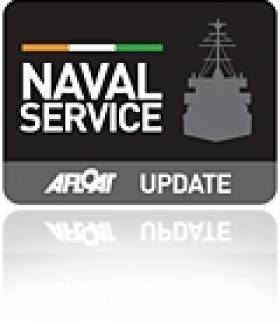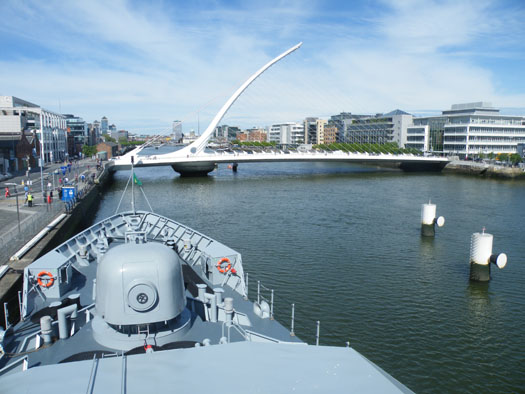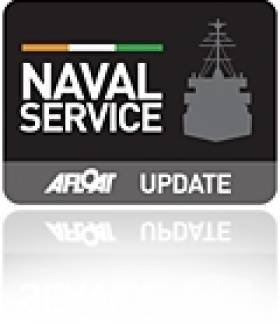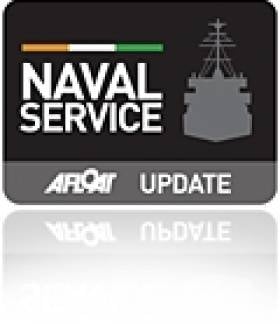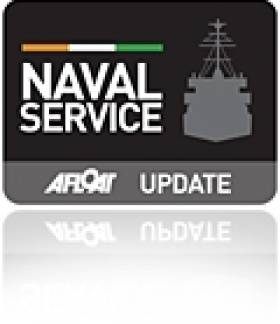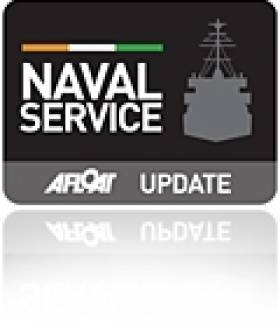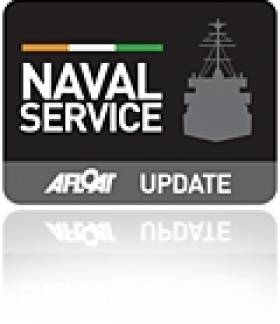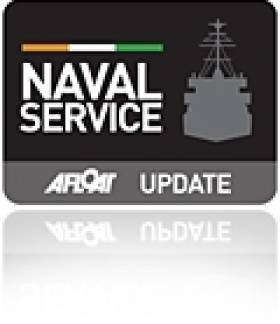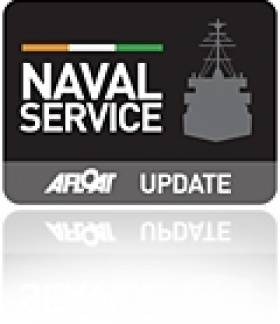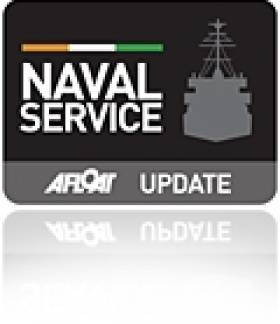Displaying items by tag: Navy
#SamuelBeckett- A niece of Samuel Beckett, Caroline Murphy performed the honour of naming the Naval Service's newest OPV, L.É. Samuel Beckett (P61) and at her side An Taoiseach and Minister for Defence Enda Kenny witnessed the customary champagne bottle smash against the bow, writes Jehan Ashmore.
In his address, An Taoiseach said "the naming and commissioning carried with it a great sense of pride and anticipation for all Naval Service personnel. L.E. Samuel Beckett will be a tremendous asset to the Naval Service. I know that the ship's first captain, Commander Ken Minehane and his crew are eagerly looking forward to working up the new ship to its full potential".
The €50m L.E. Samuel Beckett named after the Nobel Prize winning playright, took place along Sir John Rogerson's Quay. Also on the quayside is the statue of the founding father of the Argentine Navy, Admiral William Brown who hailed from Foxford, Co. Mayo. Ahead of the L.E. Samuel Beckett's bow is the Liffey bridge that also bears the same name of the playright.
The appropriate backdrop to the historic occasion included the commissioning of the OPV90 class newbuild into the Naval Service which took place in front of an invited audience as well as the public during glorious conditions.
Among the Government representives was the newly appointed Minister for Justice and officials from shipbuilders, Babcock Marine & Technology, Appledore in north Devon, which floated out the newbuild last November and saw her completed last month as yard no. 194.
The vessel which docked yesterday (see photos), was blessed and following this the L.E. Samuel Beckett's captain, Commander Ken Minehan read out the commissioning warrant to the ship's coy. Then the captain was 'piped' on board the vessel that was officially accepted as a state ship.
L.E. Samuel Beckett – the view from one bridge to another!

Captain Ken Minehan is 'piped' on board
The gangway also saw the ships company (off 44 personnel and 10 more for trainees) embark on the newest member of the Naval Service which has restored an eight-strong fleet follwing the decommissioning of L.E. Emer last year.
A sister of the newbuild, L.E. James Joyce (P62) which is constructed of 55 modular sections before been assembled is due to enter service next year. Together the 'Beckett' class cost €108m and among their primary roles are fishery protection, SAR, drug interdiction and monitoring of pollution incidents. Her main armement is the bow-mounted 76mm OTO Melara gun.
On board L.E. Samuel Beckett is an iconic photograph of the ship's namesake taken at Le Petit Café, Paris, in December 1985. This was Beckett's favourite place to meet his friends. The photographer, John Minihan was also on board to discuss the famous photograph with An Taoiseach, Captain Minehan and Caroline Murphy.
The other branches of the Defence Forces attended the ceremony, the Irish Army and Air Corps which provided a fly-past that tracked above the Liffey quays and involved a CASA Maritime Fisheries Patrol aircraft.
As guests explored the new vessel, the Army No. 1 Band played Adele's soundtrack to the James Bond film 'Skyfall' which all added to the celebratory atmosphere. Tomorrow (Sunday) afternoon, the newbuild will be open to the public between 2 and 5pm.
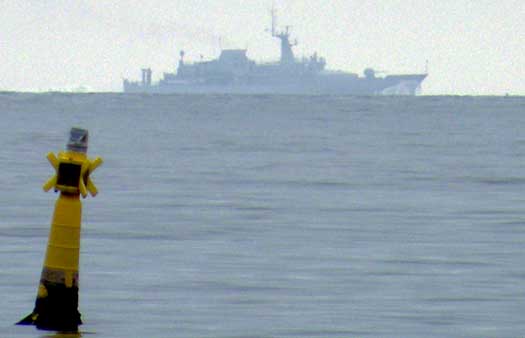
L.E. Samuel Beckett on first patrol after naming ceremony and is seen here off Killiney Bay
Irish Naval Ship LÉ Samuel Beckett Arrives on the Liffey
#samuelbeckett – The newest Naval Service ship L.É. Samuel Beckett (P61), the first of a pair OPV90 offshore patrol class newbuilds, docked in Dublin Port for the first time this morning and aptly close to her namesake bridge, writes Jehan Ashmore.
She sailed from the Naval Service Base on Haulbowline, Cork Harbour under captain and commander Ken Minehane and a crew of 55. Tomorrow morning, the OPV90 class newbuild costing €50m will be named and commissioned into service during a ceremony held at Sir John Rogerson’s Quay.

L.E.Samuel Beckett makes her Liffey debut Photo: Jehan Ashmore
An Taoiseach and Minister for Defence, Mr. Enda Kenny, T.D., will host the naming and commissioning ceremonies for the newbuild which will be named by Ms. Caroline Murphy, niece of Mr. Samuel Beckett. As previously reported the vessel will be open to public tours (2-5pm) tomorrow and also the same times on the Sunday.
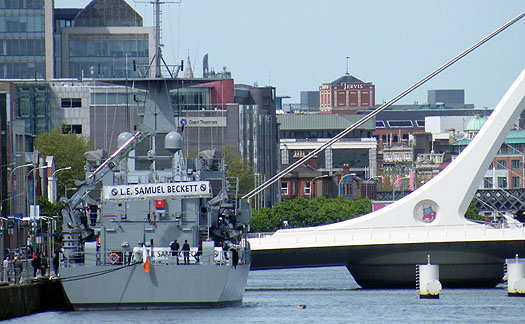
L.E. Samuel Beckett and the bridge also bearing her name. Photo: Jehan Ashmore
The newbuild is one of a pair ordered from Babcock Marine's north Devon shipyard, where L.E. James Joyce (P62) is under construction. She is expected to be completed and delivered in 2015. The sisters represent a €100m plus investment to upgrade an ageing fleet. The entry of this latest new tonnage is a direct replacement for L.E. Emer, which was sold last year to Nigerian interests.
L.É. Samuel Beckett’s Commissioning Ceremony to Take Place Close to Iconic Namesake Bridge
#LESamuelBeckett- The newest Naval Service OPV, L.É. Samuel Beckett (P61), the first of a pair of OPV90 class newbuilds, is to be commissioned into service at a ceremony held close to Dublin city's Samuel Beckett swing-bridge on Saturday, writes Jehan Ashmore.
It is fitting that the newbuild which cost €49m is to be commissioned close to the Dublin's most modern bridge that spans the Liffey since its installation in 2009.
Likewise of the navy's namesake newbuild, the swing-bridge arrived to the capital by sea!... having been constructed in the Netherlands was towed on a barge-pontoon and 'floated-in' (see photo) to Dublin Port.
If you are to compare the length of the bridge's span and that of the newbuild OPV, the bridge which was inspired by Santiago Calatrava is 123 metres long while that of the newbuild OPV90 class refers to her 90 metre length.
Public Tours
After completion of official proceedings on the Saturday morning, L.E Samuel Beckett will according to a Naval Service spokesperson speaking to Afloat.ie, be made available for her first public tour.
The inaugural tour is between 2-5pm on Saturday afternoon and repeated during the same hours the next day.
The 'Beckett' class newbuild was 'floated out' from Babcock Marine shipyard in north Devon last November made her delivery voyage to the Naval Base on Haulbolwine last month. She is of a design based from her predecessor the 'Roisin' class and that of STX Marine, Canada.
Notably, she is more than 10m longer in length and has an increased crew compliment of 55, compared to the 44 crew each of older half-sisters, L.E. Roisin and L.E. Niamh.
L.E. Samuel Beckett follows in the wake of L.E. Emer (P21), the veteran OPV that she directly replaced and which berthed opposite the Convention Centre on her final farewell visit to the capital on the occasion of Flightfest. She also made a special cruise in Dublin Bay for former crew members.
The former naval vessel sold to Nigerian interests and she still remains at Cork Dockyard, at a berth outside the dry-dock facility.
#FisheryDetention – The day after the Naval Service's newest OPV90 class L.E. Samuel Beckett arrived at Haulbowline, the navy's second oldest unit, the 2001 built L.É. Niamh detained a Spanish registered fishing vessel, writes Jehan Ashmore.
L.É. Niamh carried out the detention 100 nautical miles south of Union Hall, the detention was in regards of an alleged breach of fishing regulations. The OPV80 class sister, the leadship L.E. Roisin also detained a Spanish fishing vessel almost a fortnight ago.
The newbuilds likewise of their pair of OPV 80 predecessors, the leadship 'Roisin' class are based from this design and that by STX Canada. However, the north Devon shipyard that built the Roisin sisters were then completed by Appledore Shipbuilders and which would later go into administration and where Babcock Marine took over in 2003.
According to the Naval Service, today's detained fishing vessel was escorted by L.É Niamh to Castletownbere, Co Cork and handed over to An Gardaí Síochána.
In total this year there were 169 vessels boarded by the Naval Service, 17 warnings issued and this latest detention is the fourth fishing vessel detained so far this year.
#LEsamuelBeckett – L.E. Samuel Beckett (P61) the first of a pair of OPV 90m class newbuilds, each costing €49m, arrived into Cork Harbour this morning, marking a momentous chapter in the history of the Irish Naval Service, writes Jehan Ashmore.
The 90m vessel of almost 2,000 tonnes sailed overnight from Babcock Marine's Appledore shipyard in north Devon, a distance of approximately 145 nautical miles.
However that distance actually refers to her first sight of the Irish coast off Ballycotton, where the east-Cork coastal community last weekend welcomed their very own with the return of the former lifeboat, the RNLB Mary Stanford of Daunt Lightship rescue fame.
L.E. Samuel Beckett, an enhanced 'Roisin' class OPV 80m offshore patrol vessel then made the short coastal passage to round Roches Point Lighthouse, prior to completing her delivery voyage within the natural harbour.
She docked at the Naval Base on Haulbowline, at the foot of the naval headquarters control tower that overlooks the island which has a basin. The basin is not constrained to tides as it has no lock gate, can berth the fleet that has now been restored to the original eight-strong fleet.
Beforehand, the fleet which was one short following the decommissioning of L.E. Emer (P20) last September that took place in Cork city-centre quays marking the end of an era and also the future with her direct replacement.
The newbuild was built on the banks of the River Torridge, where her keel was laid down in May 2012 and two years later L.E. Samuel Beckett is to named at a ceremony on 17 May along Dublin's city-centre quays, close to the Samuel Beckett swing-bridge.
The same building hall at Bidna downriver of Bideford also built L.E. Roisin (P51) in 1999 and L.E. Niamh (P52) in 2001 respectively. Then the yard which was founded in 1855 was owned by Appledore Shipbuilders until it went into administration in 2003.
International global engineering group, Babcock through its marine division brought the yard, and is one of only a handful of facilities remaining in the UK that is capable of building naval ships.
L.E. Samuel Beckett is to have a crew of 54 and she is replacement of L.E. Emer, the oldest unit of the naval fleet, which was built in 1978 at Verolme Cork Dockyard (VCD).
The 'Emer' still remains at the same yard in Rushbrooke, though current owners Cork Drydock carry out repair and maintenance work.
Work on the vessel has taken place to adapt her for a new role as the former leadship 'Emer' class vessel was sold last year to Nigerian shipping interests Uniglobe.
L.E. Samuel Beckett On Way after Builders Sea-Trails
#LEsamuelBeckett – Yesterday The Irish Times reported that the Irish Naval Service new €50 million offshore patrol vessel, LE Samuel Beckett (P61) is to sail in to Cork Harbour this morning (Wednesday 30 April) and welcomed to join the fleet at the Haulbowline Naval Base.
The ship, built by Babcock Marine at Appledore in Devon, has been undergoing sea trials for the past few months but last night the Naval Service took ownership of the vessel and its captain, Lt Cmdr Ken Minihane and his crew of 45, headed for Cork.
The ship will spend about a week at Haulbowline being fitted out with a number of armaments before sailing for Dublin, where a special commissioning ceremony is due to take place beside the Samuel Beckett Bridge on May 17th. Click for more on this story.
Devon-Built OPV L.E. Samuel Beckett Handed to Naval Service
#LEsamuelBeckett – The first of a pair of newbuild OPV's, the €50m (£41m) L.E. Samuel Beckett (P61) will be handed over to the Irish Naval Service at a Devon shipyard later, reports BBC News.
The 90m (295ft) offshore patrol vessel is the first completed ship to be built at Appledore Shipyard, near Bideford, since 2002.
The Naval Service ordered two vessels from the shipyard (Babcock Marine) in October 2010 for €99m (£81m). The second, to be name James Joyce (P62) is currently under construction. Samuel Beckett will be used for fisheries and coastal protection. For more from the BBC, click HERE to include an amidships photo of the newbuild class.
As previously reported on Afloat.ie, L.E. Samuel Beckett, the OPV 90 leadship or enhanced 'Roisin' class, carried out her shipbuilders sea-trails in the Bristol Channel, which earlier this month for example involved trials included a call offshore of Ifracombe on the North Devon coast and repeated circuits around Lundy Island.
L.E. Samuell Beckett was floated out last November from the builders hall dry-dock for the first time into the River Torridge. Asides her increased length another notable spot the difference, when taken at a glance is the enclosed bulky looking mainmast as distinct to the lattice structure of her predecessors.
It will be interesting see how her sister L.E. James Joyce will appear, should any minor or major design revisions be required when she is due for completion in 2015.
Last week L.E. Roisin (P51) detained a Spanish registered fishing vessel last week for alleged breaches of fishing regulations approximately 100 nautical miles south-west of Mizen Head.
Spanish Fishing Vessel Detained off Mizen Head
#TrawlerDetained – LÉ Roisin (P51) a Naval Service OPV detained a Spanish registered fishing vessel last week for alleged breaches of fishing regulations.
The fishing vessel was detained approximately 100 nautical miles south-west of Mizen Head and headed to Castletownbere, Co.Cork at the weekend and from where she was handed over to the Gardaí.
So far this year, the Naval Service have carried out 250 boardings and 17 warnings issued, and with the Spanish vessel becoming the third vessel detained for alleged infringements of fisheries regulations also in 2014.
Naval Service Newbuild OPV L.E. Samuel Beckett Conducts Sea Trials in Bristol Channel
#LESamuelBeckett – The Naval Service newest newbuild OPV L.E. Samuel Beckett (P61) this week has undergone her shipbuilders sea-trails in the Bristol Channel, writes Jehan Ashmore.
The 1,900 tonnes OPV90 class 'enhanced Roisin class' which cost €49m was floated-out in November, carried out sea-trials and among her route included a call offshore of Ifracombe on the North Devon coast and around Lundy Island.
She returned yesterday to her builders, Babcock Marine in Appledore which is approached through the estuary of where the rivers Taw and Torridge meet. The shipyard is sited on the muddy tidal banks of the Torridge, which flows downriver from nearby Bideford.
Navy Ship LE Niamh Operating In Stormy Seas off the Irish Coast
#navy – A view from the bridge of LE Niamh, shows just how rough conditions can be around our coast for the Irish Navy on patrol. But, as this Defence Forces footage reveals, the 78m vessel is designed for just such winter North Atlantic operations.
The ship, the youngest in the Irish fleet, was designed by STX Canada Marine (formerly Kvaerner Masa Marine) and has an all-steel hull based on the Mauritian Vigilant patrol vessel launched in 1995, but without the helicopter deck and hangar facilities.
The high level of automation incorporated into the ship's systems allows the ship to be operated with just 44 crew including six officers.


























